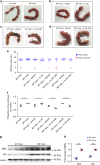Human placental trophoblast cells contribute to maternal-fetal tolerance through expressing IL-35 and mediating iTR35 conversion
- PMID: 31601798
- PMCID: PMC6787064
- DOI: 10.1038/s41467-019-12484-z
Human placental trophoblast cells contribute to maternal-fetal tolerance through expressing IL-35 and mediating iTR35 conversion
Abstract
During pregnancy, trophoblast cells sustain the maternal-fetal tolerance via expressing and secreting various chemokines and cytokines. Our previous study revealed the expression of interleukin-35 (IL-35) in human first-trimester trophoblasts. Here we show that IL-35 is expressed in both human first-trimester primary trophoblast cells and a trophoblast cell line. Trophoblast cells inhibit the proliferation of human naive conventional T cells (Tconv cells) and convert suppressed Tconv cells into iTR35 in an IL-35-dependent manner. Mechanistically, trophoblast cell derived IL-35 mediates its function through phosphorylation of STAT1 and STAT3. In vivo studies confirm that mice with immunologically spontaneous abortion have lower levels of IL-35 and iTR35 cells at the maternal-fetal interface, and neutralizing anti-IL-35 mAb enhances abortion rates. Meanwhile, exogenous IL-35 induces iTR35 and prevents immunological abortion. Our findings thus suggest that trophoblast cells have a critical function in preserving maternal-fetal tolerance via secreting IL-35 during pregnancy.
Conflict of interest statement
The authors declare no competing interests.
Figures






References
Publication types
MeSH terms
Substances
LinkOut - more resources
Full Text Sources
Research Materials
Miscellaneous

